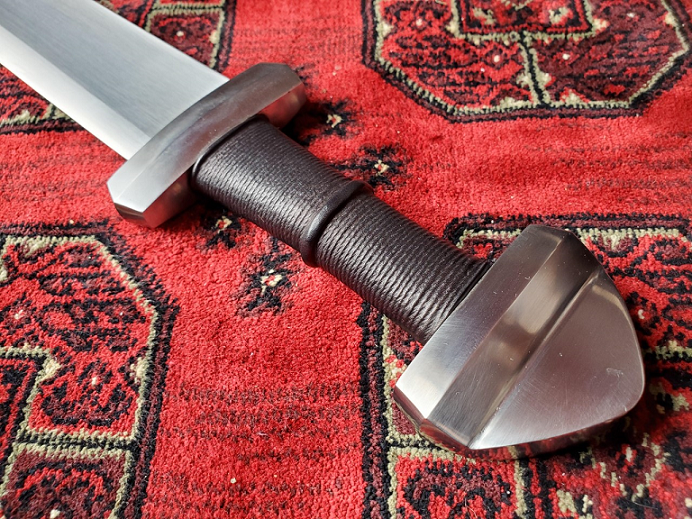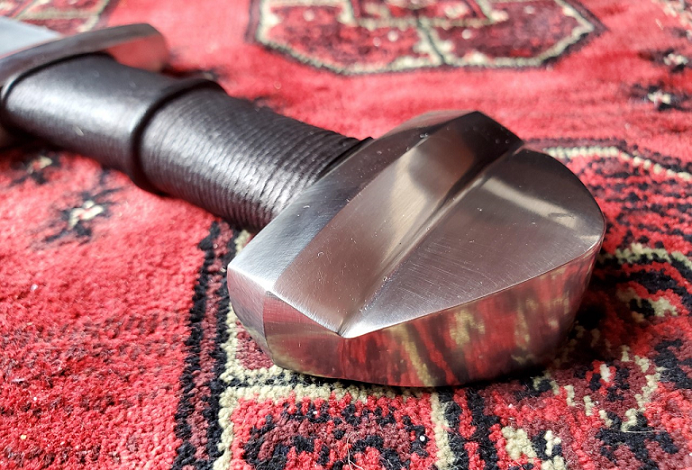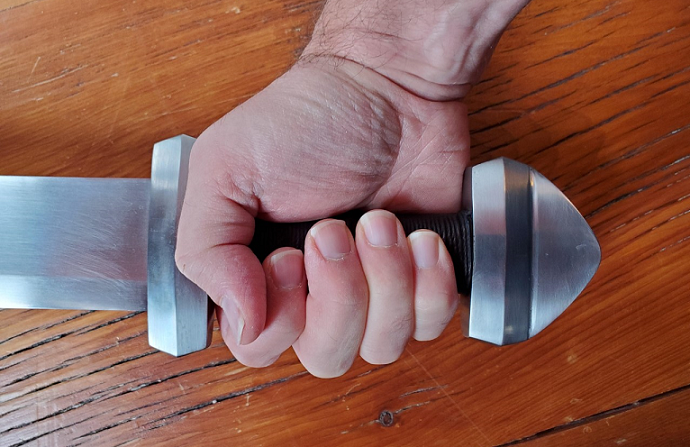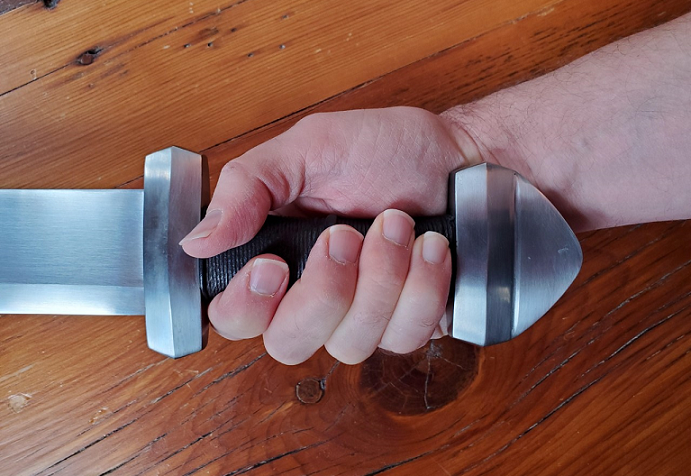| Author |
Message |
J.D. Crawford

|
 Posted: Thu 31 Dec, 2020 2:19 pm Post subject: Albion Berserker Review Posted: Thu 31 Dec, 2020 2:19 pm Post subject: Albion Berserker Review |
 |
|
Preamble
I don’t usually review Albions, because most of them have already been reviewed and usually there are no big surprises (I mean that as a compliment). However, the Berserker is a bit unusual and (other than some Youtube reviews) it has not got a lot of attention. A couple of people asked me to review mine, so, by popular demand, here goes…
Introduction
If you’re new to Viking swords, you might be surprised that many of them were single-edged. This style of Viking sword was particularly popular in Norway and is also found where the Norse were active, such as the coastal / island regions running along the North/West of Scotland and North/East Ireland. Jan Petersen (the great categorizer of Viking swords) reported that these tend to be a bit heavier than the usual Viking sword, and typically had the ‘triangular hat’ family of upper guard/pommels (e.g., types B, C, H) accompanied by canoe-shaped lower guards (corresponding to the cross in medieval swords). Fun fact: some consider this type to be a transitional form from the dark age long seax to the medieval falchion, although (if I recall correctly) that is apparently debated. Considering its popularity, this type is rather poorly represented among modern replicas. (I can only think of three current production swords, including the one reviewed here).
Overview: the Albion Berserker
This model has been around for years but I don’t think it is one of their more popular models. It never made high enough on my list to merit ordering a new one and waiting for year, but it intrigued me enough to watch out for a 2nd hand model, with the one in question finally coming up for sale early this year (2020). I ended up waiting months to get it due to COVID-related shipping delays, but it was worth the wait.
Besides the obvious single edge, this sword has several other interesting characteristics. First the back of the blade has a very thick spine almost to the tip, continuing to a very wide fuller, and then a chisel-like cutting edge. Second, Albion and/or Peter Johnsson chose to give it a type B pommel, which is an earlier form and seems to be less common than the later type C and H. Perhaps Albion did this for variety, since their ‘Hersir’ model has the type H. Type B has an oddly angular profile when viewed from the side (sort of vase shaped) whereas C and H are rectangular & triangular respectively, with H more rounded at the edges. There are other subtle differences. The Albion pommel is is correctly peened (not rivetted like type H), although I think that technically the B was a two-piece. Likewise the lower guard is quite angular. The overall look is quite striking: the blade is quite curvilinear, whereas the handle furniture is very angular and surprisingly modern looking (yet historically correct).
Statistics:
Total Length: 36 inches.
Blade Length: 29 5/8”
Blade width: 1 29/32”
Blade thickness: 3/16” at initial spine, tapering linearly to 3/32” near tip.
‘Cross’ width: 3 ¼”
‘Pommel’ width: 2 ¾”
Pommel/guard height: 1 13/16”
CoG: 3 3/4”
Proximal Harmonic Node: middle of the grip
Distal Harmonic Node (optimal striking point): ~6” from tip
Distal Pivot Point: right at the tip
Weight: sorry, can’t find my usual scale (a digital fishing scale), but the Albion/KoH figures feel right: 2.6 lbs.
Fit and Finish
Well, its an Albion, so what do you expect. Everything is tight and nicely done, from the satin finish to the grip (single central riser with overwrap impression the leather) and the overall proportions. I don’t see any secondary bevel on the blade. I’m particularly impressed by the fuller. My meagre knowledge of blade smithing says that wider fullers are harder to make than narrow fullers, whether by chisel or power tools. I’ve owned some high end type Xs that had uneven fullers. This is the widest fuller I have ever seen, and yet its perfect. This speaks to Albion’s method of CNC milling followed by hand finishing.
Handling & Performance.
Always my favorite part to evaluate because it can be so much affected by subtle features. Going by the numbers (weight, CoG etc), one can predict that this relatively compact sword has a chunky feel, but very maneuverable. No surprise, it does not have the familiar dynamic feel of a two-edge Viking sword but rather feels like a big machete or butcher blade. The tip is easy to control (I guess owing to the pivot point near tip). This sword can be held in either the hammer grip or handshake grip (see below), although the hammer grip presses the edge of my palm against the angular upper guard. My main complaint is that all those angles on the pommel become uncomfortable when transitioning between these grips (as I like to do), but of course this can be mitigated by wearing a glove. Despite the easy tip control, thrusting is not intuitive with this asymmetric blade and grip design, but in the hammer grip one could powerfully leverage an upward thrust beneath the opponents shield toward the groin, or around the right side of the shield into the abdomen (not that I have plans to try that).
Most obviously, this is a chopper. The curving tip and forward optimal striking point would make this idea for tip slices, although the whole blade is quite impervious to vibration and should cut well all along. I have no intentions of testing this on such an expensive blade, but if you look online you can find a you-tuber happily chopping a log with this sword. It would interesting to see this sword go through the ‘kill test’ they have on ‘Forged in Fire’. I don’t think this blade would pass entirely through a pig carcass in one swing -its not that big- but I’m confident it would bit deep on every cut.
Conclusions
This sword may not be to everyone’s taste, but it’s a unique and important piece that belongs in the collection of anyone who is really serious about Viking swords. I’d like it a bit better with a type H pommel, but overall I think it’s a very fine piece, with some attractive features.
Regards, JDC
PS - Happy New Year!
 Attachment: 346.46 KB Attachment: 346.46 KB

 Attachment: 900.1 KB Attachment: 900.1 KB

 Attachment: 710.71 KB Attachment: 710.71 KB

 Attachment: 590.14 KB Attachment: 590.14 KB

 Attachment: 616.03 KB Attachment: 616.03 KB

 Attachment: 924.56 KB Attachment: 924.56 KB

 Attachment: 396.6 KB Attachment: 396.6 KB

|
|
   |
 |
J. Nicolaysen

|
 Posted: Thu 31 Dec, 2020 6:10 pm Post subject: Posted: Thu 31 Dec, 2020 6:10 pm Post subject: |
 |
|
|
Nice review Doug. I have a berserkr also and I think you really nail the same thoughts I have about mine. The fore-guard definitely can rub a little. It is a massive chopper, but still finely made. It's a fun and different sword.
|
|
  |
 |
J.D. Crawford

|
 Posted: Fri 01 Jan, 2021 7:02 am Post subject: Posted: Fri 01 Jan, 2021 7:02 am Post subject: |
 |
|
| J. Nicolaysen wrote: | | Nice review Doug. I have a berserkr also and I think you really nail the same thoughts I have about mine. The fore-guard definitely can rub a little. It is a massive chopper, but still finely made. It's a fun and different sword. |
Thanks J. I meant to keep it short but then I get carried away with historical details like pommel development and how they affect handling.
BTW, I meant to show the business end of the sword as well. Here it is:
 Attachment: 886.82 KB Attachment: 886.82 KB

|
|
   |
 |
|
Carl W.
|
 Posted: Fri 01 Jan, 2021 11:16 pm Post subject: Posted: Fri 01 Jan, 2021 11:16 pm Post subject: |
 |
|
|
Thank you very much for this review & the detail photos. It confirms that the blade & fuller are impressive. The photos & comments re the Type B pommel are appreciated. Aside - did you / who made that shield?
|
|
  |
 |
J.D. Crawford

|
 Posted: Sat 02 Jan, 2021 12:11 pm Post subject: Posted: Sat 02 Jan, 2021 12:11 pm Post subject: |
 |
|
| Carl W. wrote: | | Thank you very much for this review & the detail photos. It confirms that the blade & fuller are impressive. The photos & comments re the Type B pommel are appreciated. Aside - did you / who made that shield? |
Thanks. The shield was made by Valentine Armoury when they were in Canada (I think they moved to Hollywood). It was part of a liquidation of props from 'Beowulf an Grendel'. Now I wish I had bought Gerard Butler's Helmet for 200 more. That would be worth something now.
|
|
   |
 |
Paul Hansen

|
|
  |
 |
J.D. Crawford

|
 Posted: Sun 03 Jan, 2021 4:50 pm Post subject: Posted: Sun 03 Jan, 2021 4:50 pm Post subject: |
 |
|
Thanks Paul.
He seems to be employing a handshake grip (like my second picture) except drawing back even further back on the handle, so that both the fingers and palm are on the upper guard/pommel. I've tried that on Viking swords with extremely short grips but found it places a lot of stress on the wrist and index finger. It also weakens one's hold on the sword. For me, the optimal handshake position is to have the fingers fully on the grip with the 'pinky' against the upper guard and the pommel leveraged against the wrist-end of the palm.
Further, in my humble opinion, if one loosens up the grip a bit and let the sword move as it wants to, one can naturally transition from hammer (in positions where the wrist is orthogonal to the handle) to handshake (when wrist is parallel to handle), still giving most of the reach advantage discussed in the video.
This is simply my personal preference, but if you try it for a while you might just like it.
Regards, JD
|
|
   |
 |
|
Len Parker
|
|
  |
 |
Bryan Heff

|
 Posted: Tue 05 Jan, 2021 1:24 pm Post subject: Posted: Tue 05 Jan, 2021 1:24 pm Post subject: |
 |
|
Thanks for this excellent review. I have always thought the single edge Viking swords were interesting but I have never been hit with the "bug" on them...as in I must get one. That tip picture makes me think twice about owning one now. Certainly looks like it could "do the business" in terms of chopping and cutting heavier targets.
Show this type of sword to your average non-sword person and I bet 95% would say it was some fantasy design made for a Hollywood movie....really is pretty intriguing that such an unusual mix of single edge, wide fuller and chunky hilt furniture is 100% historic.
The church is near but the roads are icy. The tavern is far but I will walk carefully. - Russian Proverb
|
|
  |
 |
Paul Hansen

|
 Posted: Tue 05 Jan, 2021 1:57 pm Post subject: Posted: Tue 05 Jan, 2021 1:57 pm Post subject: |
 |
|
| J.D. Crawford wrote: | | He seems to be employing a handshake grip (like my second picture) except drawing back even further back on the handle, so that both the fingers and palm are on the upper guard/pommel. |
Actually he does hold his thumb on the backside of the grip, in the sabre fencing style, rather than on the side as you do in your picture.
But around 11:36 in the video, Roland does seem to have picked up some nasty blister on his thumb from somewhere...
Around 18:02 (the sparring) he does use various grips and positions for his thumb.
I don't have a really suitable sword to experiment with these ideas at the moment. My Type X has the wrong type of grip (too long and too round) and sabres / cutlasses lack a pommel. Fencing / test cutting with the sabre grip with cutlasses does take a bit getting used to (I found it rather heavy in the beginning), but it does work and it does improve control a lot.
I have a single edged Viking type B on order from Vladimir Cervenka with a 9cm grip, which I designed to be comfortable in a classic sabre grip, with the thumb resting against the lower guard and the pommel in the aft side of the palm, as well as when holding further back on the pommel with the thumb somewhere in the middle of the grip. We'll see how that works out. I think it will take some time to get used to it, but I also think that Roland presents a really good case in the video.
What I wonder though, the Berserker has a kind of "inverse" triangle kind of pommel, which widens towards the top. Although this is the (exact) pommel which was drawn in Petersen's book, this inversion isn't (in my opinion) really typical for type B pommels: most get thinner towards the top of the pommel, as you find on H hilts. Or stay the same thickness throughout like on type C hilts. What I wonder is, if this inversion makes more sense if you hold the sword really by the pommel instead of in a handshake or sabre grip.
Are they really?
E.g. in the uppermost picture of your link, the 2nd, 3rd and 4th hilt seem assymetrical to me.
But I think in most cases you'd find out only by measuring.
And, if some swords have a certain design feature, not all need to have that feature without invalidating the ideas behind said feature. E.g. not all cars have visible spoilers, but a lot of cars have some aerodynamic feature on the back of the roof or on the trunk with a similar effect.
On the other hand, is the assymetry a design feature or the result of corrosion or poor conservation techniques? It's difficult to see on photo's...
|
|
  |
 |
J.D. Crawford

|
 Posted: Wed 06 Jan, 2021 5:10 pm Post subject: Posted: Wed 06 Jan, 2021 5:10 pm Post subject: |
 |
|
|
I'm no expert in Viking martial arts (if any one really is), but one thing that struck me in Roland's video was the fencing contained a lot of finesse, wrist-centered work that to me seemed reminiscent of modern fencing techniques. I guess we can't know for sure what Vikings did, but if there's any truth to the Sagas, at least some of the time they must have used some pretty heavy, shield splitting, limb chopping blows. For that I think one needs a firmer grip on the handle. Just my opinion.
|
|
   |
 |
|
Joe Maccarrone
Location: Burien, WA USA Joined: 19 Sep 2003
Posts: 190
|
 Posted: Thu 07 Jan, 2021 12:39 pm Post subject: Posted: Thu 07 Jan, 2021 12:39 pm Post subject: |
 |
|
| J.D. Crawford wrote: | | I'm no expert in Viking martial arts (if any one really is), but one thing that struck me in Roland's video was the fencing contained a lot of finesse, wrist-centered work that to me seemed reminiscent of modern fencing techniques. I guess we can't know for sure what Vikings did, but if there's any truth to the Sagas, at least some of the time they must have used some pretty heavy, shield splitting, limb chopping blows. For that I think one needs a firmer grip on the handle. Just my opinion. |
I found his video unconvincing for that and other reasons.
The wear pattern on the pommels is exactly what we'd expect from rubbing against an arm/body, or resting a hand on them. If someone were to look at the wear pattern on my Glocks from years of carry in duty and concealment holsters, and try to infer something about their method of employment when fired...the results might be hilarious.
|
|
  |
 |
Paul Hansen

|
 Posted: Thu 07 Jan, 2021 11:14 pm Post subject: Posted: Thu 07 Jan, 2021 11:14 pm Post subject: |
 |
|
Well, after a bit of training, I can make pretty convincing cuts through milk jugs using modern fencing attacks with a cutlass. But it took a good while to get used to the weight. Seeing how fluent Roland is with his sword, speaks for a LOT of practice. Which Viking age warriors would likely have had as well.
With my Type X, I have difficulty but I blame that on the grip, which is fairly round and barrel shaped so it's also tapers towards the guard, so I can't place my thumb properly.
I should get my sword somewhere in April, can't wait!
|
|
  |
 |
|
|
You cannot post new topics in this forum
You cannot reply to topics in this forum
You cannot edit your posts in this forum
You cannot delete your posts in this forum
You cannot vote in polls in this forum
You cannot attach files in this forum
You can download files in this forum
|
All contents © Copyright 2003-2025 myArmoury.com — All rights reserved
Discussion forums powered by phpBB © The phpBB Group
Switch to the Basic Low-bandwidth Version of the forum
|

